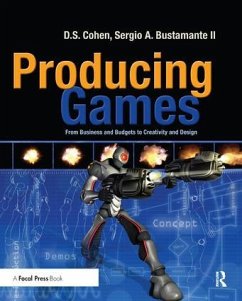- Gebundenes Buch
- Merkliste
- Auf die Merkliste
- Bewerten Bewerten
- Teilen
- Produkt teilen
- Produkterinnerung
- Produkterinnerung
Helps you to master the secrets behind video game production. This title lets you discover how to lead a team, communicate effectively, budget, schedule, staff, and design quality next-generation games. It walks you through different stages of the production process with a focus on the part the producer plays at each phase.
Andere Kunden interessierten sich auch für
![Interactive Storytelling for Video Games Interactive Storytelling for Video Games]() Josiah LebowitzInteractive Storytelling for Video Games182,99 €
Josiah LebowitzInteractive Storytelling for Video Games182,99 €![Write Your Way Into Animation and Games Write Your Way Into Animation and Games]() Write Your Way Into Animation and Games173,99 €
Write Your Way Into Animation and Games173,99 €![Google Sketchup Workshop Google Sketchup Workshop]() Google Sketchup Workshop174,99 €
Google Sketchup Workshop174,99 €![Realistic Architectural Rendering with 3ds Max and V-Ray Realistic Architectural Rendering with 3ds Max and V-Ray]() Jamie CardosoRealistic Architectural Rendering with 3ds Max and V-Ray157,99 €
Jamie CardosoRealistic Architectural Rendering with 3ds Max and V-Ray157,99 €![Animated Realism Animated Realism]() Judith KrigerAnimated Realism157,99 €
Judith KrigerAnimated Realism157,99 €![Design Essentials for the Motion Media Artist Design Essentials for the Motion Media Artist]() Angie TaylorDesign Essentials for the Motion Media Artist159,99 €
Angie TaylorDesign Essentials for the Motion Media Artist159,99 €![Tradigital 3ds Max Tradigital 3ds Max]() Richard LapidusTradigital 3ds Max189,99 €
Richard LapidusTradigital 3ds Max189,99 €-
-
-
Helps you to master the secrets behind video game production. This title lets you discover how to lead a team, communicate effectively, budget, schedule, staff, and design quality next-generation games. It walks you through different stages of the production process with a focus on the part the producer plays at each phase.
Hinweis: Dieser Artikel kann nur an eine deutsche Lieferadresse ausgeliefert werden.
Hinweis: Dieser Artikel kann nur an eine deutsche Lieferadresse ausgeliefert werden.
Produktdetails
- Produktdetails
- Verlag: CRC Press
- Seitenzahl: 304
- Erscheinungstermin: 2. August 2017
- Englisch
- Gewicht: 558g
- ISBN-13: 9781138427518
- ISBN-10: 1138427519
- Artikelnr.: 52160665
- Herstellerkennzeichnung
- Libri GmbH
- Europaallee 1
- 36244 Bad Hersfeld
- gpsr@libri.de
- Verlag: CRC Press
- Seitenzahl: 304
- Erscheinungstermin: 2. August 2017
- Englisch
- Gewicht: 558g
- ISBN-13: 9781138427518
- ISBN-10: 1138427519
- Artikelnr.: 52160665
- Herstellerkennzeichnung
- Libri GmbH
- Europaallee 1
- 36244 Bad Hersfeld
- gpsr@libri.de
D.S has worked with some of the industry giants in everything from production and design, to marketing and PR, and he has been credited in more than 50 games. He runs the Classic Video Game section of About.com. Sergio A. Bustamante II is currently producing, developing, and designing games for Brash Entertainment. Brash is a new publisher focused in on developing great games based on film IP. Currently, he is working on three unannounced titles, with some AAA developers, that will hit the store shelves in 2009 - 2010. Prior to Brash Entertainment, he was at EA-Tiburon for two years working on Superman Returns and working in their external developers group. Before that, he was at Treyarch for almost 5 years as an Audio Director and Producer involved in hit titles like Spider-Man: The Movie Game, Spider-Man 2, NHL 2K2, NHL 2K3, and Draconus: Cult of the Wyrm. Sergio is a veteran of the industry and has been involved in it for 14 years.
Producing Games Introduction: The Producer's Role (10%) This section of the
book introduces the reader to the game industry's history and how the role
of the producer grew from the need to manage extremely complicated
projects. A producer's day to day tasks are also introduced to place the
reader, at least mentally, in the producer role. By the end of this section
the reader will understand what a producer does and how they go about doing
it - the remaining sections of the book expose secrets for making good
decisions and strategy along the way. Section One: Production Primer (15%
of the book) This section covers the very basics of getting started in
producing games, including building the team and the work environment. It
will briefly cover the different disciplines of game development, what the
do, how they relate to one another and even what tools they need to do
their work. Section Two: Preproduction (30% of the book) Game development
can be broken into three major phases: preproduction, production, and
finalling. The preproduction phase is the most fun, but is also the most
critical phase. Creating the concept and the production plan and
subsequently proving both with a playable version of the game is extremely
difficult. This section will help producers really focus on what is
important. Section Three: Production (30% of the book) The production phase
is grueling, but as each week passes the game becomes more and more real.
The producers role here becomes more difficult mostly because of the
exploding size of the team and the incredible velocity they bring to their
work. Each day down the wrong path requires multiple days to recover, and
the producer must constantly monitor it all. This section will give
producers an idea of what to expect and how to manage the production cycle.
Section Four: Finalling (10% of the book) The movie industry goes through
post-production, a phase where a very small team cuts and edits until their
creation is exactly the way the visionaries want it. In games, this process
take the bulk of the production team and a growing quality assurance team,
and is a lot more like using 100 sledgehammers to put a fine details on an
ice sculpture. This section covers how a team changes the way they work and
how to manage the inevitable overtime to get them to zero bugs before your
deadline. Section Five: Other Things to Ponder (5% of the book) This
section is more of a grab bag of random things every game producer must
know, such as how to go about choosing middleware and dealing with remote
teams or multi-studio development. It also covers some of the important
aspects of studio finance and the law - especially important for those that
want to start up their own game development studio. ------------ Companion
web site: Game Production - Forum/Wiki: Community portal for the
readership. A place for readers to interact directly with the author, each
other, and other members of the computer game industry. Additional links on
the site to sample project layouts and ms project macros; production forms
and charts; schedule examples, planning spreadsheets and other scheduling
tools. We're looking at a similar site to that associated with his current
book: Game Coding Complete: has over 900 registered members, over 5600
posts, and an average of 3,500 hits per day - the author visits this web
site at least 20 times per week non-stop for over five years, and anyone
posting a question has a response in a few hours. Visit this site at
http://www.mcshaffry.com/GameCode/
book introduces the reader to the game industry's history and how the role
of the producer grew from the need to manage extremely complicated
projects. A producer's day to day tasks are also introduced to place the
reader, at least mentally, in the producer role. By the end of this section
the reader will understand what a producer does and how they go about doing
it - the remaining sections of the book expose secrets for making good
decisions and strategy along the way. Section One: Production Primer (15%
of the book) This section covers the very basics of getting started in
producing games, including building the team and the work environment. It
will briefly cover the different disciplines of game development, what the
do, how they relate to one another and even what tools they need to do
their work. Section Two: Preproduction (30% of the book) Game development
can be broken into three major phases: preproduction, production, and
finalling. The preproduction phase is the most fun, but is also the most
critical phase. Creating the concept and the production plan and
subsequently proving both with a playable version of the game is extremely
difficult. This section will help producers really focus on what is
important. Section Three: Production (30% of the book) The production phase
is grueling, but as each week passes the game becomes more and more real.
The producers role here becomes more difficult mostly because of the
exploding size of the team and the incredible velocity they bring to their
work. Each day down the wrong path requires multiple days to recover, and
the producer must constantly monitor it all. This section will give
producers an idea of what to expect and how to manage the production cycle.
Section Four: Finalling (10% of the book) The movie industry goes through
post-production, a phase where a very small team cuts and edits until their
creation is exactly the way the visionaries want it. In games, this process
take the bulk of the production team and a growing quality assurance team,
and is a lot more like using 100 sledgehammers to put a fine details on an
ice sculpture. This section covers how a team changes the way they work and
how to manage the inevitable overtime to get them to zero bugs before your
deadline. Section Five: Other Things to Ponder (5% of the book) This
section is more of a grab bag of random things every game producer must
know, such as how to go about choosing middleware and dealing with remote
teams or multi-studio development. It also covers some of the important
aspects of studio finance and the law - especially important for those that
want to start up their own game development studio. ------------ Companion
web site: Game Production - Forum/Wiki: Community portal for the
readership. A place for readers to interact directly with the author, each
other, and other members of the computer game industry. Additional links on
the site to sample project layouts and ms project macros; production forms
and charts; schedule examples, planning spreadsheets and other scheduling
tools. We're looking at a similar site to that associated with his current
book: Game Coding Complete: has over 900 registered members, over 5600
posts, and an average of 3,500 hits per day - the author visits this web
site at least 20 times per week non-stop for over five years, and anyone
posting a question has a response in a few hours. Visit this site at
http://www.mcshaffry.com/GameCode/
Producing Games Introduction: The Producer's Role (10%) This section of the
book introduces the reader to the game industry's history and how the role
of the producer grew from the need to manage extremely complicated
projects. A producer's day to day tasks are also introduced to place the
reader, at least mentally, in the producer role. By the end of this section
the reader will understand what a producer does and how they go about doing
it - the remaining sections of the book expose secrets for making good
decisions and strategy along the way. Section One: Production Primer (15%
of the book) This section covers the very basics of getting started in
producing games, including building the team and the work environment. It
will briefly cover the different disciplines of game development, what the
do, how they relate to one another and even what tools they need to do
their work. Section Two: Preproduction (30% of the book) Game development
can be broken into three major phases: preproduction, production, and
finalling. The preproduction phase is the most fun, but is also the most
critical phase. Creating the concept and the production plan and
subsequently proving both with a playable version of the game is extremely
difficult. This section will help producers really focus on what is
important. Section Three: Production (30% of the book) The production phase
is grueling, but as each week passes the game becomes more and more real.
The producers role here becomes more difficult mostly because of the
exploding size of the team and the incredible velocity they bring to their
work. Each day down the wrong path requires multiple days to recover, and
the producer must constantly monitor it all. This section will give
producers an idea of what to expect and how to manage the production cycle.
Section Four: Finalling (10% of the book) The movie industry goes through
post-production, a phase where a very small team cuts and edits until their
creation is exactly the way the visionaries want it. In games, this process
take the bulk of the production team and a growing quality assurance team,
and is a lot more like using 100 sledgehammers to put a fine details on an
ice sculpture. This section covers how a team changes the way they work and
how to manage the inevitable overtime to get them to zero bugs before your
deadline. Section Five: Other Things to Ponder (5% of the book) This
section is more of a grab bag of random things every game producer must
know, such as how to go about choosing middleware and dealing with remote
teams or multi-studio development. It also covers some of the important
aspects of studio finance and the law - especially important for those that
want to start up their own game development studio. ------------ Companion
web site: Game Production - Forum/Wiki: Community portal for the
readership. A place for readers to interact directly with the author, each
other, and other members of the computer game industry. Additional links on
the site to sample project layouts and ms project macros; production forms
and charts; schedule examples, planning spreadsheets and other scheduling
tools. We're looking at a similar site to that associated with his current
book: Game Coding Complete: has over 900 registered members, over 5600
posts, and an average of 3,500 hits per day - the author visits this web
site at least 20 times per week non-stop for over five years, and anyone
posting a question has a response in a few hours. Visit this site at
http://www.mcshaffry.com/GameCode/
book introduces the reader to the game industry's history and how the role
of the producer grew from the need to manage extremely complicated
projects. A producer's day to day tasks are also introduced to place the
reader, at least mentally, in the producer role. By the end of this section
the reader will understand what a producer does and how they go about doing
it - the remaining sections of the book expose secrets for making good
decisions and strategy along the way. Section One: Production Primer (15%
of the book) This section covers the very basics of getting started in
producing games, including building the team and the work environment. It
will briefly cover the different disciplines of game development, what the
do, how they relate to one another and even what tools they need to do
their work. Section Two: Preproduction (30% of the book) Game development
can be broken into three major phases: preproduction, production, and
finalling. The preproduction phase is the most fun, but is also the most
critical phase. Creating the concept and the production plan and
subsequently proving both with a playable version of the game is extremely
difficult. This section will help producers really focus on what is
important. Section Three: Production (30% of the book) The production phase
is grueling, but as each week passes the game becomes more and more real.
The producers role here becomes more difficult mostly because of the
exploding size of the team and the incredible velocity they bring to their
work. Each day down the wrong path requires multiple days to recover, and
the producer must constantly monitor it all. This section will give
producers an idea of what to expect and how to manage the production cycle.
Section Four: Finalling (10% of the book) The movie industry goes through
post-production, a phase where a very small team cuts and edits until their
creation is exactly the way the visionaries want it. In games, this process
take the bulk of the production team and a growing quality assurance team,
and is a lot more like using 100 sledgehammers to put a fine details on an
ice sculpture. This section covers how a team changes the way they work and
how to manage the inevitable overtime to get them to zero bugs before your
deadline. Section Five: Other Things to Ponder (5% of the book) This
section is more of a grab bag of random things every game producer must
know, such as how to go about choosing middleware and dealing with remote
teams or multi-studio development. It also covers some of the important
aspects of studio finance and the law - especially important for those that
want to start up their own game development studio. ------------ Companion
web site: Game Production - Forum/Wiki: Community portal for the
readership. A place for readers to interact directly with the author, each
other, and other members of the computer game industry. Additional links on
the site to sample project layouts and ms project macros; production forms
and charts; schedule examples, planning spreadsheets and other scheduling
tools. We're looking at a similar site to that associated with his current
book: Game Coding Complete: has over 900 registered members, over 5600
posts, and an average of 3,500 hits per day - the author visits this web
site at least 20 times per week non-stop for over five years, and anyone
posting a question has a response in a few hours. Visit this site at
http://www.mcshaffry.com/GameCode/








